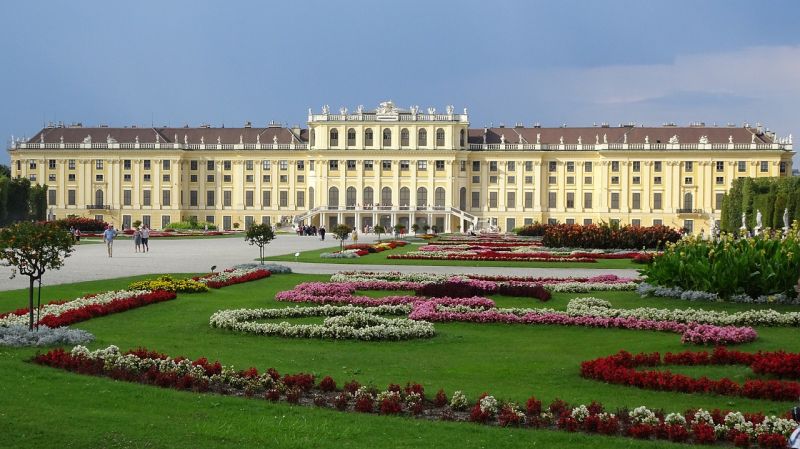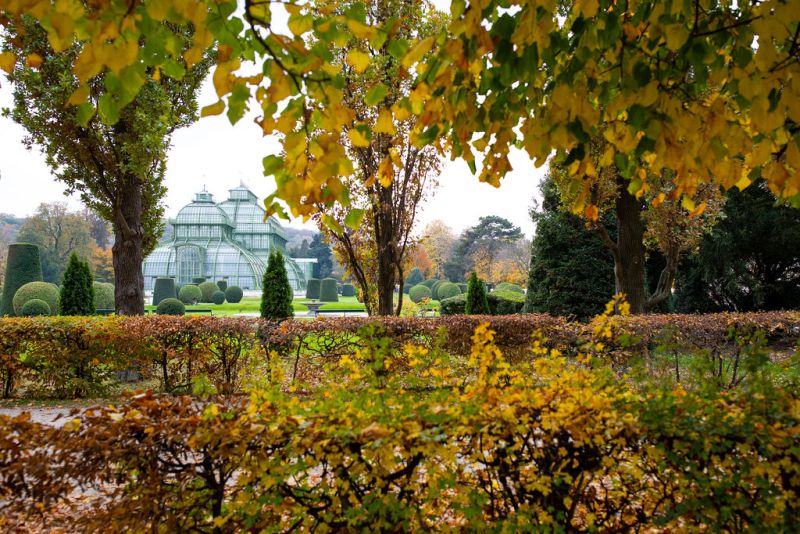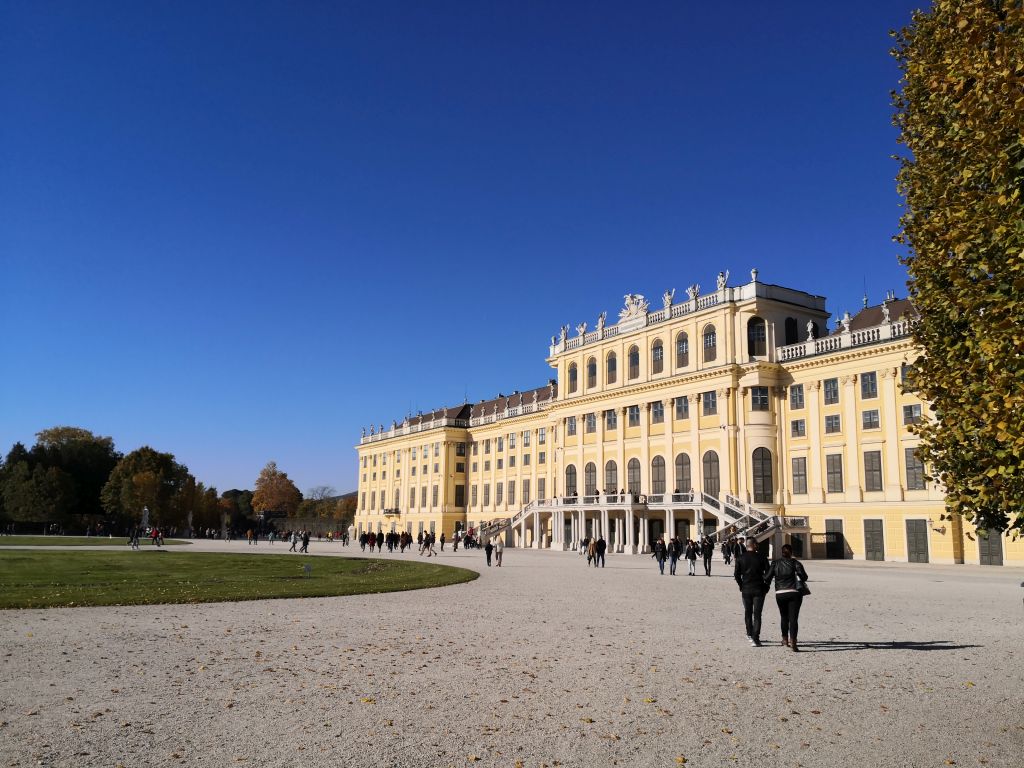
Address
Schönbrunner Schloßstraße 47, 1130 Wien
GPS
48.18498935, 16.311568430619
Web
Monday
10:00-17:00
Tuesday
10:00-17:00
Wednesday
10:00-17:00
Thursday
10:00-17:00
Friday
10:00-17:00
Saturday
10:00-17:00
Sunday
10:00-17:00
Schönbrunn Palace was the Habsburg rulers‘ primary summer residence, and it is located in Hietzing, Vienna’s 13th district. It’s one of the country’s most significant architectural, cultural and historical landmarks, built in Rococo style. It has become a major tourist attraction in both Vienna and Austria, since the 1950s.
The complex consists of a palace with many areas opened for the public, museums, and gardens. The gardens are home to Imperial Carriage Museum, Crown Prince Garden, Orangery Garden, Maze & Labyrinth, Zoo, Palm House, and Desert Experience House. Usually, it takes at least an entire day to see all points of interest in the area.

Schönbrunn Palace facts
1. Location
- Address: Schönbrunner Schlossstrasse 47, 1130 Vienna, Austria
- Position: Situated in the Hietzing district of Vienna, approximately 8 kilometers southwest of the city center.
2. Historical Background
- Origins: The site originally housed a mansion called Katterburg, purchased by Holy Roman Emperor Maximilian II in 1569.
- Development: The palace was transformed into a grand residence by Empress Eleonora Gonzaga in the 17th century. It was expanded and remodeled into its current form under the reign of Empress Maria Theresa in the mid-18th century.
3. Architectural Style
- Design: The palace is a prime example of Baroque architecture with Rococo interior elements.
- Architects: The principal architects were Johann Bernhard Fischer von Erlach and his son, Joseph Emanuel Fischer von Erlach.
4. Significance
- Imperial Residence: Schönbrunn served as the summer residence of the Habsburg monarchs for centuries.
- Historical Events: It has been the site of numerous significant events, including the Congress of Vienna in 1814-1815 and meetings between historical figures such as Napoleon and the Austrian Emperor.
5. UNESCO World Heritage Site
- Recognition: Schönbrunn Palace and its gardens were designated a UNESCO World Heritage Site in 1996 for their historical and cultural significance.
6. The Palace Complex
- Rooms: The palace boasts 1,441 rooms, of which 40 are open to the public.
- Grand Gallery: The most famous room, used for balls, receptions, and banquets.
- Millions Room: Known for its exquisite Rococo decoration and rare porcelain.
7. Gardens and Grounds
- Area: The palace gardens cover approximately 1.2 square kilometers.
- Features: Include formal gardens, fountains, statues, a maze, and the Gloriette—a grand hilltop pavilion offering panoramic views of Vienna.
- Orangery: One of the largest Baroque orangeries in the world, used for growing citrus trees and other exotic plants.
8. Attractions within the Grounds
- Tiergarten Schönbrunn: The world’s oldest continuously operating zoo, established in 1752.
- Palm House: A large greenhouse containing a vast collection of exotic plants.
- Botanical Garden: Home to a variety of rare and indigenous plant species.
9. Cultural and Educational Importance
- Museums: The palace houses several museums, including the Imperial Carriage Museum.
- Concerts and Events: The Great Gallery and other rooms host classical music concerts and cultural events.
10. Public Access and Tours
- Opening Hours: Open daily, with varying hours depending on the season.
- Tours: Visitors can choose from various tour options, including the Imperial Tour, the Grand Tour, and guided tours focusing on specific aspects of the palace’s history and architecture.
- Ticket Prices: Range from €16-€24 for adults, with discounts for children, students, and seniors.
11. Visitor Experience
- Annual Visitors: Schönbrunn Palace attracts over 2.5 million visitors annually, making it one of Austria’s most visited attractions.
- Facilities: The palace offers cafes, restaurants, and gift shops, enhancing the visitor experience.
12. Historical Residents
- Notable Figures: The palace was home to many notable Habsburgs, including Empress Maria Theresa, Emperor Franz Joseph I, and Empress Elisabeth (Sisi).
13. Restorations and Preservation
- Maintenance: The palace and its gardens undergo continuous restoration and preservation efforts to maintain their historical integrity and beauty.
These facts illustrate the grandeur, historical significance, and enduring appeal of Schönbrunn Palace, making it a must-visit destination for anyone traveling to Vienna.
The palace has more than 1,400 rooms, from which 45 can be visited, so there are several different tour types offered for visitors: grand tour, imperial tour, or ground floor tour.
Schönbrunn (“beautiful spring”) was a popular hunting and recreational area for royals, long before anything was built there. The original idea was to build a hunting lodge, but gradually project grew to become a massive palace, which took its final shape and style in the 18th century.
The history of Schönbrunn Palace
In 1695, Leopold I entrusted the final planning to Johann Bernhard Fischer von Erlach who had already designed the first project during 1692-1693. The construction of castle was planned on the hill of today’s Gloriette. Since this planning was too costly, Fischer delivered a second, much simpler draft, for a building below the hill and near the Wien River.
This was accepted by Leopold, and the construction began during 1695-1696. The core of the middle section was completed around 1700. Joseph (I) preferred Schönbrunn to all of his palaces but was unable to live to its completion, as he died in 1711. The side wings were completed in 1713. Charles VI hardly visited Schönbrunn because he preferred to reside in the New Favoriten.

After Maria Theresa’s accession to the throne, a new era began for Schönbrunn. The renovation she ordered was carried out by Nikolaus Pacassi from 1744-1749 (removal of the gable, retraction of the mezzanine floor in the central projection, installation of the balconies and side stairs, and the two galleries).
The palace gardens were laid out by Jean Trehet during 1705/1706, and around 1750 Jean Nicolas Jadot de Ville-Issey designed the Chamber and Crown Prince Gardens. Around 1765 it was redesigned by Johann Ferdinand Hetzendorf von Hohenberg and Adrian van Steckhovenmade.
In 1752 Jadot de Ville-Issey laid out the menagerie in a circular shape. Hohenberg completed the Gloriette in 1775 and the Obelisk in 1777, the pavilion for the “Beautiful Fountain” was built in 1779, and the Neptune Fountain (with sculptures by Franz Anton von Zauner) was completed in 1780.
Maria Theresa’s son Joseph (emperor from 1765) celebrated his marriage to Isabella of Parma in Schönbrunn.
Franz I and his brother Archduke Johann ordered various improvements, mainly the layout of the gardens. Napoleon had his residence in Schönbrunn from December 12 to 25, 1805, and from May to October 16, 1809 (on October 14, 1809, the Peace of Schönbrunn was signed there). During the Congress of Vienna in 1815, Schönbrunn was the scene of massive celebrations.
The palm house, located in the area of the former Dutch botanical garden, was built in 1881/82 according to plans by Franz Xaver Segenschmid.
Franz Joseph I died in Schönbrunn on November 21, 1916. He lived whole his life in the palace. Karl I signed his resignation from the government in Schönbrunn in 1918. After the proclamation of the republic, the castle became the property of the Austrian state. The damage that the castle and Gloriette had suffered from bombs in World War II was repaired.

After the end of WWII, Schönbrunn was in the hands of the British occupation troops during the Allied occupation, as the 13th district belonged to the British occupation zone of Vienna.
The Schönbrunn was used as the British headquarters. However, the castle was returned to the Austrian government on May 31, 1948, and completely released on July 29, 1948. On September 4, 1948, the showrooms were reopened.
Today, the showrooms in the main building are also used for state receptions on a case-by-case basis. In the outbuildings, there are apartments for senior federal officials.
Both palace and gardens are part of UNESCO World Heritage since 1996 and the property is managed by Schloss Schönbrunn Kultur und Betriebsges company, owned by the Republic of Austria.
Palace was a host to many historical events, such as The Congress of Vienna, which was hosted in the Grand Gallery in the years 1814/15, and Emperor Charles I signed a renouncement from state affairs in 1918 and subsequently dethroned in 1919. Mozart was visiting the palace as a six-year-old and already a child musical prodigy of the era.
